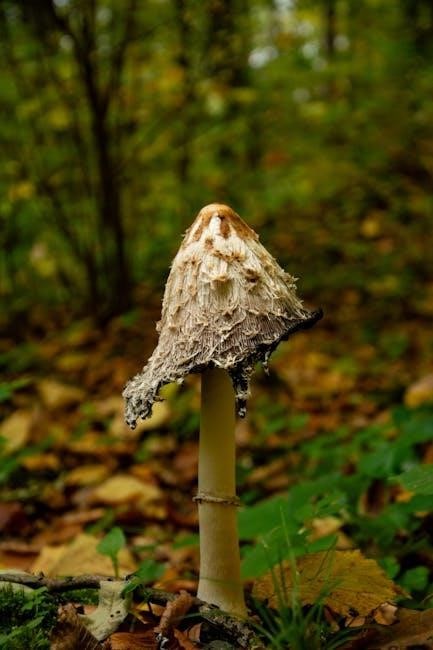A field guide to the fungi of Australia provides essential information on species
Overview of Fungal Diversity
A field guide to the fungi of Australia reveals a vast array of species, with diverse shapes, sizes, and colors, found in various habitats across the country. The guide covers a wide range of fungal diversity, including different types of fungi, such as mushrooms, molds, and yeasts. It provides an overview of the various species, their characteristics, and distribution patterns, helping readers to understand and identify the different types of fungi. The guide also includes information on the unique features of Australian fungi, such as their adaptations to the country’s climate and geography. With its comprehensive coverage, the guide is an essential resource for anyone interested in learning about the fascinating world of Australian fungi. The guide is filled with detailed descriptions and stunning photographs, making it a valuable tool for both beginners and experienced fungal enthusiasts, exploring the diversity of Australian fungi.
Importance of Field Guides
Field guides play a crucial role in promoting the understanding and appreciation of Australian fungi, by providing accurate and accessible information on species identification and distribution. They serve as a valuable resource for researchers, conservationists, and enthusiasts, helping to facilitate the discovery and documentation of new species. The importance of field guides lies in their ability to bridge the gap between scientific research and public awareness, making complex information available to a broader audience. By using field guides, individuals can contribute to the ongoing effort to catalog and protect Australia’s unique fungal heritage, and gain a deeper appreciation for the natural world. The guides also provide a framework for further research and exploration, inspiring new generations of mycologists and naturalists to explore the fascinating world of Australian fungi, and to work towards its conservation and preservation.
Characteristics of Australian Fungi
Australian fungi exhibit diverse characteristics and features naturally
Size and Shape Variations
Australian fungi display a wide range of size and shape variations, with some species growing to be quite large, while others remain relatively small. The shapes of these fungi can also vary greatly, from simple and rounded to complex and intricately detailed. Some species have distinctive caps or stems, while others have more unusual features, such as bright colors or unique textures. The diversity of size and shape among Australian fungi is a key aspect of their biology and ecology, and is an important factor in identifying and classifying different species. By studying the size and shape variations of Australian fungi, researchers and enthusiasts can gain a deeper understanding of these fascinating organisms and their role in the natural world. This knowledge can also inform conservation efforts and help to protect these unique and important species.
Habitat and Distribution Patterns
Australian fungi can be found in a wide range of habitats, from tropical rainforests to arid deserts; Different species are adapted to specific environments, with some thriving in moist, humid conditions, while others are more tolerant of dryness and heat. The distribution patterns of Australian fungi are also influenced by factors such as soil type, vegetation, and climate. Some species are found only in specific regions, while others are more widespread. By understanding the habitat and distribution patterns of Australian fungi, researchers and enthusiasts can better appreciate the diversity of these organisms and the importance of conserving their habitats. This knowledge can also inform efforts to manage and protect Australia’s unique fungal biodiversity, and to promote sustainable land use practices that support the health of these ecosystems. Australian fungi play a vital role in their ecosystems.

Fungal Biology and Ecology
Fungal biology and ecology studies the complex relationships between fungi and environment naturally
Roles of Fungi in Nature
Fungi play crucial roles in nature, including decomposition and nutrient cycling, forming symbiotic relationships with plants and animals, and influencing ecosystem processes and biodiversity.
Fungi are essential components of ecosystems, contributing to the health and resilience of environments.
They facilitate the exchange of nutrients between organisms, support plant growth, and regulate the populations of other organisms.
In addition, fungi are involved in the formation of soil structure, the degradation of organic matter, and the cycling of nutrients.
Their activities have a significant impact on the functioning of ecosystems, making them a vital part of the natural world.
Understanding the roles of fungi in nature is essential for appreciating the complexity and interconnectedness of ecosystems.
By studying fungi, we can gain insights into the intricate relationships between organisms and their environments, and develop a deeper appreciation for the importance of preserving biodiversity and ecosystem health.
Classification and Distribution
The classification of fungi in Australia is a complex task, with many species still awaiting discovery and description.
Fungi are distributed across various habitats, including forests, grasslands, and wetlands, with different species adapted to specific environments.
The distribution of fungi is influenced by factors such as climate, soil type, and vegetation, with some species found only in specific regions.
Classification systems are used to group fungi into categories based on their characteristics, such as morphology and molecular features.
These systems help to organize the vast diversity of fungi and facilitate identification and research.
The distribution of fungi in Australia is not uniform, with some areas harboring a greater variety of species than others.
Understanding the classification and distribution of fungi is essential for appreciating the diversity of fungal life in the Australian region and for informing conservation efforts.

Photographic Field Guide
Features superb colour photographs and detailed descriptions of species found
Comprehensive Coverage of Species
A field guide to the fungi of Australia provides a comprehensive coverage of species, with over 500 species included, featuring detailed descriptions and information on their habitats and distributions.
The guide covers a wide range of species, from the common to the rare, and includes information on their size, shape, and spore print colour, as well as their roles in nature and interactions with other organisms.
The comprehensive coverage of species makes this guide an essential resource for anyone interested in learning about the fungi of Australia, from amateur enthusiasts to professional mycologists and researchers.
The guide is the result of many decades of field work and study, and is the most comprehensive photographic field guide on Australian fungi yet published, making it a valuable addition to any mycology library or collection.
Superb Colour Photographs and Illustrations
The field guide features 548 superb colour photographs, showcasing the fungi in their natural environment, many of which are being photographed for the first time.
These high-quality images are accompanied by detailed illustrations, including watercolours and line drawings, which provide additional visual information and help to identify the different species.
The combination of photographs and illustrations makes the guide a valuable resource for anyone interested in the fungi of Australia, providing a unique and detailed visual representation of the species.
The superb colour photographs and illustrations are a key feature of the guide, making it an essential tool for identification and study, and providing a new level of understanding and appreciation for the diverse range of fungi found in Australia.
and Future Directions
The field guide to the fungi of Australia is a significant contribution to the field of mycology, providing a comprehensive and authoritative reference for researchers and enthusiasts alike.
As new species are discovered and our understanding of fungal biology and ecology evolves, future editions of the guide will be essential in reflecting these advances and continuing to promote the study and appreciation of Australian fungi.
With its thorough coverage and detailed information, the guide has set a new standard for fungal field guides, and its impact will be felt for years to come, inspiring further research and exploration of the fascinating world of Australian fungi and shaping the future of mycological studies in the region.